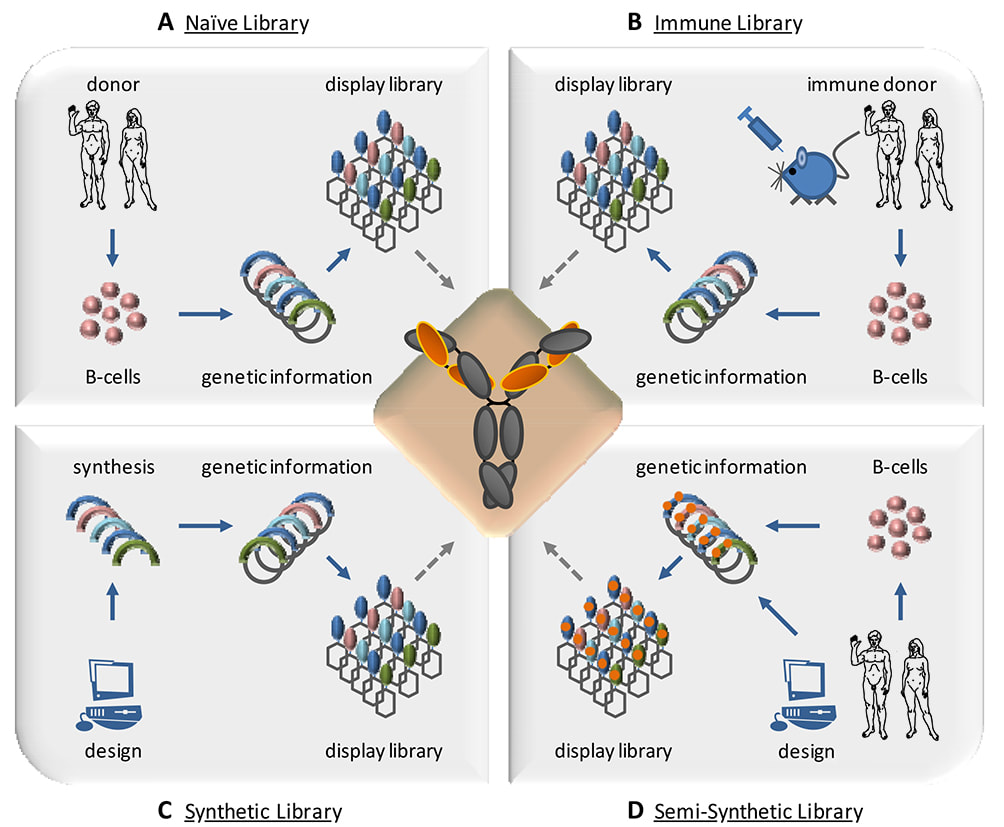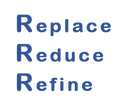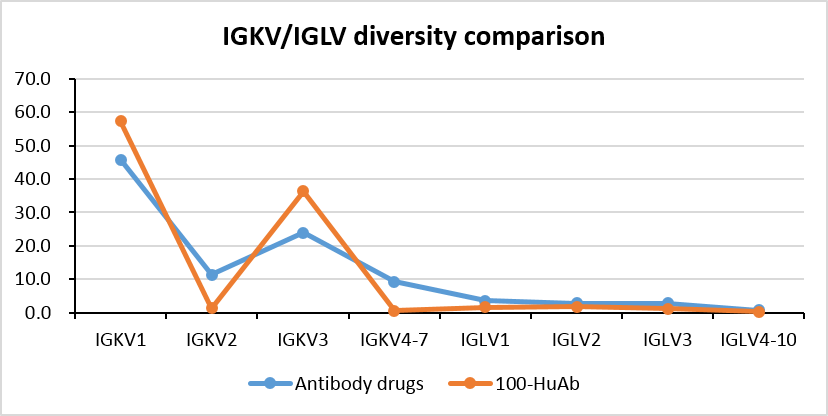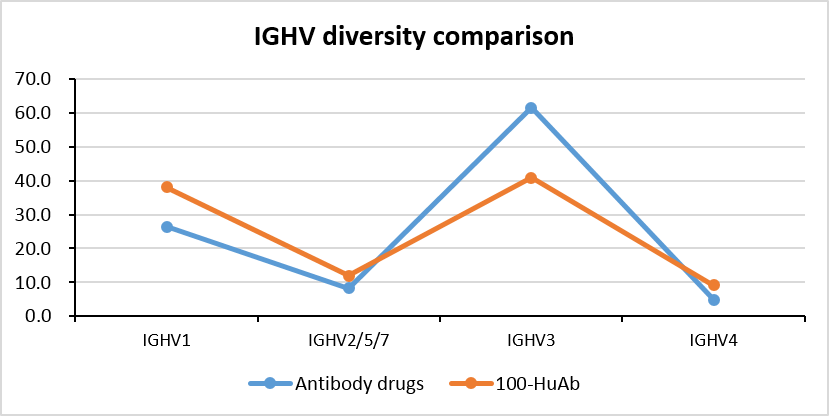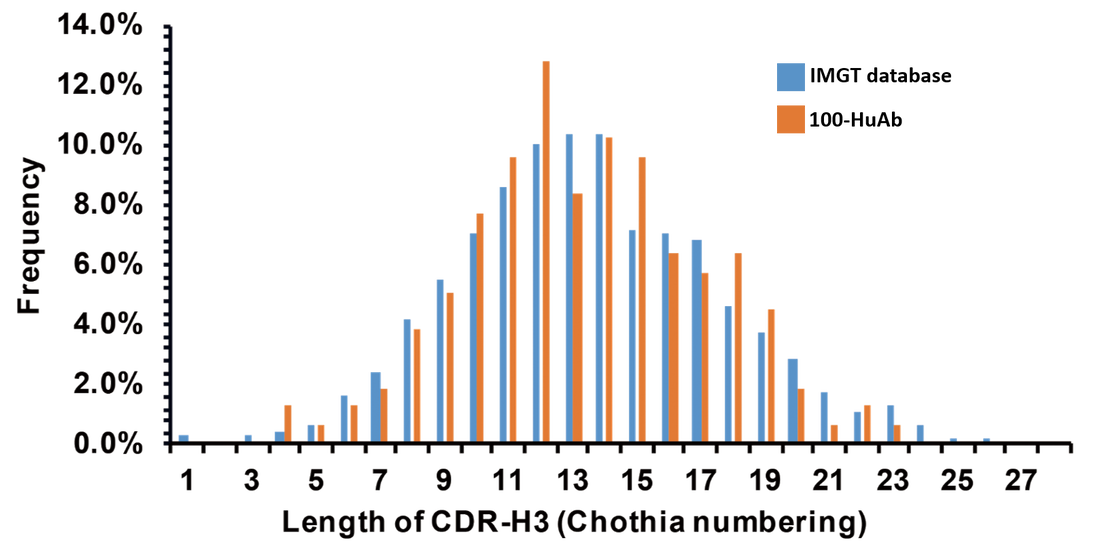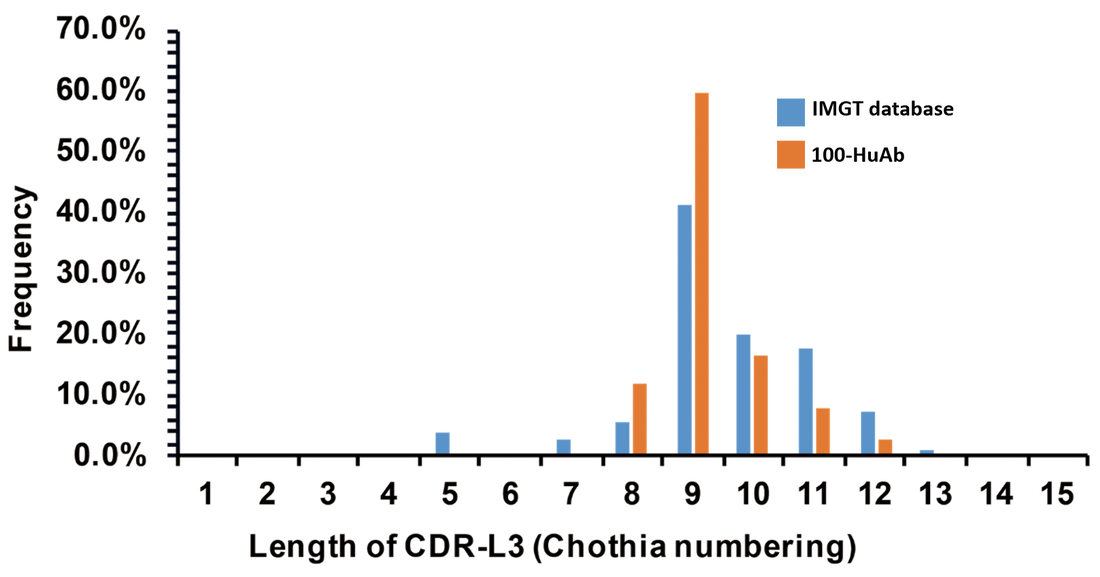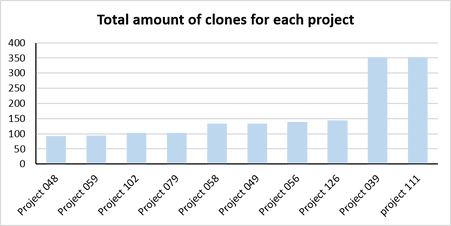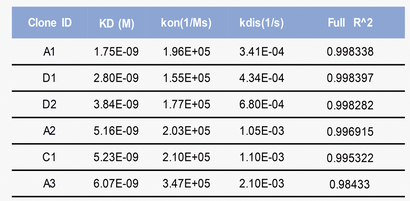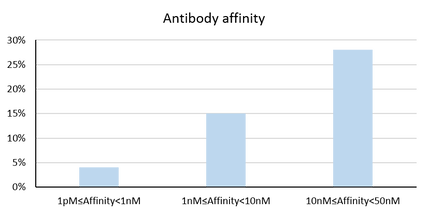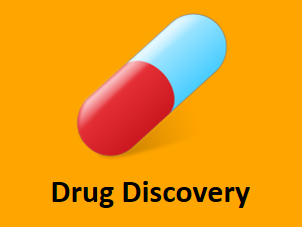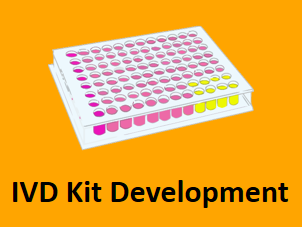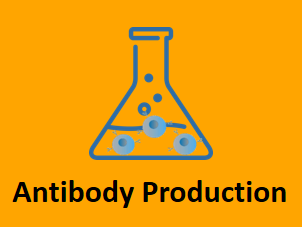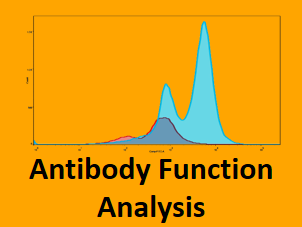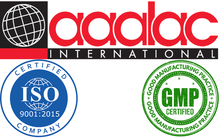Human Antibody and huABL
Previous generations of antibody drugs are either murine sourced or murine-human chimeric antibody which leads to a series of side effects in clinical due to the HAMA reaction. It was difficult to avoid the side effect in the early years since there was no alternative tool to raise large amount of drug potential antibodies. Like every scientist understood, to find human antibody directly from human host is the most ideal direction, and the method development kept on going since the early years. Scientists tried to isolate antibodies from patients and tested their cancer/tumor inhibition function. However, these antibodies are unreproducible and could only be used for protein/cell level research purpose; also their performance is far from the murine-sourced or chimeric antibodies.
Phage display technology changed the game and made it possible to raise antibody directly from human host. The immune cells are collected from healthy doners/patients then the antibody sequences are reverse transcripted into DNA. These DNA fragments are subcloned into phagemids and later each antibody is displayed on the phage. Following by biopanning, the high affinity binders are harvested.
BioBench established the Human Antibody Libraries (huABLs) based on the phage display technology, as well as plenty of engineering in order to enhance the performance of the final antibodies. Compare to the major antibody libraries from other drug discovery service suppliers, BioBench’s huABL has several advantages: 10× higher amount of individual clones; higher sequence diversity and it is comparable to nature antibody repertoire; 5× more binders after panning; and 5× higher affinity of the binders.
Phage display technology changed the game and made it possible to raise antibody directly from human host. The immune cells are collected from healthy doners/patients then the antibody sequences are reverse transcripted into DNA. These DNA fragments are subcloned into phagemids and later each antibody is displayed on the phage. Following by biopanning, the high affinity binders are harvested.
BioBench established the Human Antibody Libraries (huABLs) based on the phage display technology, as well as plenty of engineering in order to enhance the performance of the final antibodies. Compare to the major antibody libraries from other drug discovery service suppliers, BioBench’s huABL has several advantages: 10× higher amount of individual clones; higher sequence diversity and it is comparable to nature antibody repertoire; 5× more binders after panning; and 5× higher affinity of the binders.
Advantages
- Human sequenced antibodies, no worry for immunogenecity in human related research.
- Large sequence diversity, comparable to nature format.
- Antibody affinity as good as sub nM.
- Simple fragmentation process, client may choose ScFv, F(ab)2, F(ab), full sequence IgG or bi-specific Ab.
- Animal free, no need to immunize any animal.
HuAb-Express™ human antibody discovery service |
Designed for initial antibody drug research project - To start antibody drug research can be very expensive and time consuming: many millions of investment and many years of work. However, such complex operation is very tedious in fundamental research or proof-of-concept test. Researchers urgently need a compacted and rapid workflow to achieve their preliminary task. Considering the need from both research institutes and small biopharma startups, BioBench designed a one-stop-shop solution aiming at minimizing the cost and generating solid outcome.
Client only need to provide the antigen (or protein sequence/name for antigen expression first), and BioBench will ship positive selected clones to client's lab bench. No cost if fail!
Client only need to provide the antigen (or protein sequence/name for antigen expression first), and BioBench will ship positive selected clones to client's lab bench. No cost if fail!
Service and Time Line |
Content |
Deliverables |
Price |
AB210306 Guaranteed Human antibody service 1 antibody 50 days |
1. Material: protein/peptide, to be provided by client. 2. Library culture and biopanning to find the best binders. 3. ELISA method to test the top binders, titer > 1:64000. 4. 1 selected antibody to be expressed into full length human IgG antibody (mammalian expression), following by purification. 5. QC: SDS-PAGE to test purity and MW. ELISA binding test. |
• 1 selected positive antibody: 5mg purified antibody. • Antibody purity: > 90%. • QC and Report. |
|
AB210307 Guaranteed Human antibody service 3 different antibodies 50 days |
1. Material: protein/peptide, to be provided by client. 2. Library culture and biopanning to find the best binders. 3. ELISA method to test the top binders, titer > 1:64000. 4. 3 selected antibodies to be expressed into full length human IgG antibodies (mammalian expression), following by purification. 5. QC: SDS-PAGE to test purity and MW. ELISA binding test. |
• 3 selected positive antibodies: 5mg purified antibody for each antibody. • Antibody purity: > 90%. • QC and Report. |
Descriptions:
|
Human Antibody Library - Background
Muromonab is the first clinical-use approved monoclonal antibody therapy in 1986 and the one of only four with full murine sequence. Since antibody became a major class of new drugs to treat cancer and autoimmune diseases, the disadvantages of murine-originated antibody has been extensively studied. Murine antibody has a short therapeutic half-life in human body, also it may cause allergic reaction to the patients. The reason is simple due to the murine antibody is recognized by the patient immune system as foreign proteins resulting in a human anti-mouse (HAMA) response.
Subsequently, how to generate humanized antibody sequence while keeping the affinity and specificity became an important challenge in therapeutic antibody drug development.
Seeking mAb directly from human (healthy/patient) is the most efficient solution to acquire drug-potential antibody, compare to humanization of an animal antibody. In the past due to the limitation of methods, it was impossible to bring this technology out of lab and enter into the industry. Developed together with phage knowledge and modern molecular biology, phage display technology enabled the possibility of mega protein library and protein engineering. Thanks to phage display technology, we are able to acquire the antibodies from all of the animal species including human ourselves, through Human Antibody Library (huAL).
Subsequently, how to generate humanized antibody sequence while keeping the affinity and specificity became an important challenge in therapeutic antibody drug development.
Seeking mAb directly from human (healthy/patient) is the most efficient solution to acquire drug-potential antibody, compare to humanization of an animal antibody. In the past due to the limitation of methods, it was impossible to bring this technology out of lab and enter into the industry. Developed together with phage knowledge and modern molecular biology, phage display technology enabled the possibility of mega protein library and protein engineering. Thanks to phage display technology, we are able to acquire the antibodies from all of the animal species including human ourselves, through Human Antibody Library (huAL).
Human Antibody Library - Different Types
|
Human antibody library can be classified into several different types, according to the source of the sequence: immune library, naïve library, semi-synthetic library and synthetic library. The table hereunder briefly summarized the difference among these different types. The technology has been well developed so we shall expect good outcome from any type of the library.
|
immune Library |
Naïve library |
Semi-synthetic Library |
Synthetic Library |
|
Source of the sequence |
Animal immunized by specific antigen, or patient |
Non-immunized animal or human |
Non-immunized animal or human, together with partially artificial sequence |
Artificial sequence |
Affinity maturated |
Yes |
No |
No |
No |
Diversity |
Low |
High |
High |
Very high |
Highlighted Antibody Library – 100-Billion Human antibody Library (100-huABL)
To meet the improving demand from the bio-pharma industry, Bio Bench started to design and build its own 100-billion Human Naïve Antibody Library (100-huABL) for drug discovery. By adopting the PBMCs from 3000 healthy donors’, the size of the human naive antibody library finally reaches 220-billion clones which covering all of the antigens (10-million different types in theory). The 100-huABL shows high germlines diversity and CDR-H3/CDR-L3 sequence diversity which is similar to nature antibody (data from IMGT database).
Benefits and advantages
1. Full human sequence antibody, start your project with original format.
2. Low cost and reduced risk.
3. Fast, 30 - 45 days you will receive your antibody.
4. Large amount of candidate clones, up to 300+.
Specifications of the 100-HuAb
Antibody gene diversity: a primary feature of the antibody library
Antibody sequence show high diversity among nature antibodies in all of the animal species. High sequence diversity brought higher possibility to find the right antibody for a unique antigen/epitope. To keep the diversity during naive antibody library requires leading technology and know-how technical team. Bio Bench launched a series of R&D to improve the quality of the library from the beginning, Results show the 100-huABL is significantly high diverse in sequence.
Germlines diversity
In order to investigate the diversity of 100-huABL, Bio Bench analyzed the sequence of antibody drugs from both approved list (till 2018) and clinical trial list (list from 2018). Data is show in Figures. The diversity of germline does not show a significant difference between 100-huABL raised antibodies and antibody drugs.
CDR length diversity
CDR region plays the key role in determining the affinity, specificity and druggability of antibodies. High viable CDR sequence is very important CDR-H3 and CDR-L3 length and sequence are the most viable fragments among all of the 6 fragments and CDR-H3 is even far more viable than CDR-L3.
Case studies: the performances of 100-HuAb
On the platform of 100-HuAb, Bio Bench has already run 18 projects (including test projects) with therapeutic targets and 1711 clones are harvested. The amount of binders, affinity and the lead antibody functional assay are tested. Results are shown below.
Large amount of clones
The conventional hybridoma technology allows researcher to acquire 1-5 clones from each mouse and 100 mice may be killed for 300 binders with good affinity. 100-huABL does not need any additional mouse which is totally complying with 3-R principal for animal experiment. Result shows average 100 clones will be harvested, more than 300 clones are possible under customer's demand.
High affinity
100-huABL human naive antibody library is engineered and with 220-billion clones, then during biopanning process a large amount of clones can be harvested and the low affinity binders will be ignored. Therefore it will lead to a significantly increased amount of high affinity clones. Compare to the typical affinity range 50nM-200nM of other reported human naive antibody libraries, 17% of the binders harvested from 100-huABL show high affinity in pM-10nM and nearly 50% of the clones are within 50nM.

